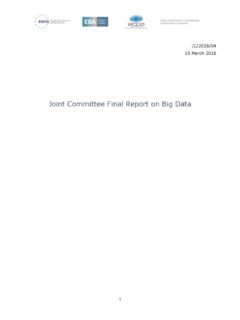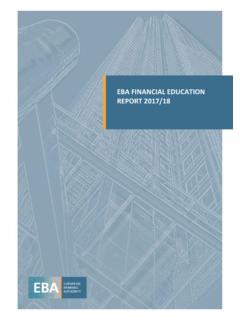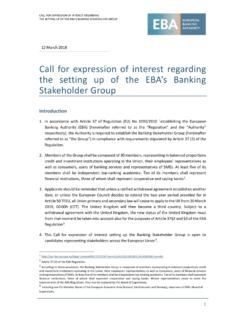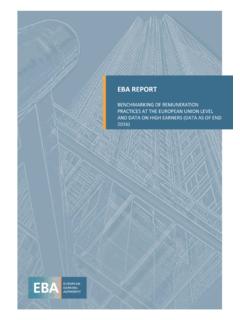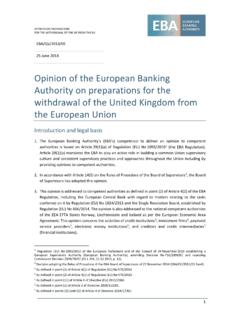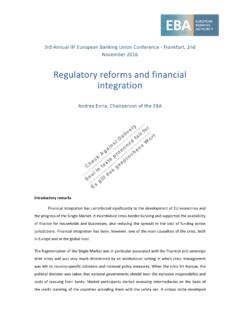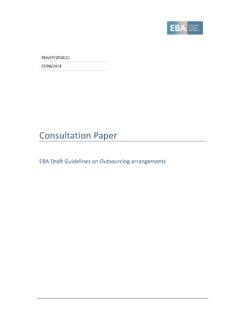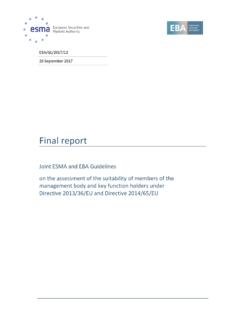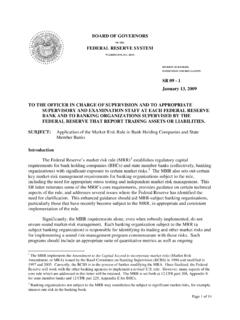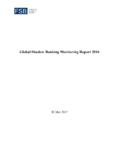Transcription of RISK ASSESSMENT OF THE EUROPEAN BANKING …
1 ISSN 1977-9097. RISK ASSESSMENT OF THE. EUROPEAN BANKING system . DECEMBER 2016. Europe Direct is a service to help you find answers to your questions about the EUROPEAN Union Freephone number (*): 00 800 6 7 8 9 10 11. (*) The information given is free, as are most calls (though some operators, phone boxes or hotels may charge you). print ISBN 978-92-9245-277-3 ISSN 1977-9089 DZ-AC-16-001-EN-C. epub ISBN 978-92-9245-279-7 ISSN 1977-9097 DZ-AC-16-001-EN-E. PDF ISBN 978-92-9245-278-0 ISSN 1977-9097 DZ-AC-16-001-EN-N. flip book ISBN 978-92-9245-276-6 ISSN 1977-9097 DZ-AC-16-101-EN-N. More information on the EUROPEAN Union is available on the Internet ( ). Luxembourg: Publications Office of the EUROPEAN Union, 2016.
2 EUROPEAN BANKING Authority, 2016. Reproduction is authorised provided the source is acknowledged. Printed by the Publications Office in Luxembourg Printed on white chlorine-free paper RISK ASSESSMENT OF THE. EUROPEAN BANKING system . DECEMBER 2016. R I S K A S S E S S M E N T O F T H E E U R O P E A N B A N K I N G SY S T E M. Contents Abbreviations 7. Executive summary 8. Introduction 10. 1. Macroeconomic environment and market sentiment 12. 2. Asset side 16. Volume trends 16. Asset quality 20. 3. Liability side 31. Market-based funding 31. Deposits 35. Central bank funding 35. 4. Capital 39. 5. Profitability 44. 6. Operational risks : ICT-related risks and legal and consumer issues 53.
3 ICT-related risks 53. Legal issues and reputational concern 54. 7. Policy implications and measures 56. Resolution of legacy assets 56. Challenges around profitable and sustainable business models 56. Operational risk 57. Annex I Samples 58. Annex II Descriptive statistics from the EBA key risk indicators 63. 3. EUROPEAN B A N K IN G A U T H O R IT Y. List of Figures Figure 1: Debt of general governments and private sector debt as a percentage of GDP (end of 2015) 12. Figure 2: Stock index STOXX Europe 600 Banks share price index and weighted average of EU bank CDS spreads by market capitalisation (average December 2011= 100) 13. Figure 3: Market sentiment: positive and negative influences 14.
4 Figure 4: Total asset and loan volumes (trillion EUR) 16. Figure 5: Expected further growth in banks' overall balance sheet 17. Figure 6: Portfolios considered for growth and for deleverage 18. Figure 7: Portfolios considered for growth and for deleverage 19. Figure 8: Reasons for asset growth and deleverage 20. Figure 9: Non-performing loans ratio 5th and 95th percentiles, interquartile range and median; numerator and denominator trends (December 2014 = 100) 21. Figure 10: Non-performing loans ratio weighted average by country 21. Figure 11: Ratios of non-performing loans and FBLs 22. Figure 12: A composite credit weakness ratio of non-performing and performing FBLs by country, Q2 2016 22.
5 Figure 13: Non-performing loan ratios by sector, Q2 2016 23. Figure 14: Portfolios which are expected to improve or deteriorate in asset quality, Q2 2016 23. Figure 15: Total exposures of EUROPEAN banks (by country of origin) towards EU non- financial sectors (by sector of the counterparty) 24. Figure 16: EDF quartile distribution by sector (non-financial) at EU level compared to EU banks' total exposures towards non-financial corporations by sector 25. Figure 17: Exposures in Europe towards non-financial sectors by banks' country of origin (as a percentage of total) and sector EDF median 26. Figure 18: Coverage ratio specific allowances for loans to total non-performing loans 5th and 95th percentiles, interquartile range and median.
6 Numerator and denominator trends (December 2014 = 100) 27. Figure 19: Coverage ratio specific allowances for loans to total non-performing loans country dispersion weighted average by country 27. Figure 20: Quadrant model showing a potential relationship between NPL and coverage ratio trends 28. Figure 21: NPL ratio versus coverage ratio (of NPLs) per country, Q2 2016 29. Figure 22: Impediments to resolving non-performing loans 29. Figure 23: Summary of IFRS 9 quantitative estimations 30. Figure 24: Intentions to attain more funding via different funding instruments 32. Figure 25: Expectations on banks' future funding channels 32. 4 R I S K A S S E S S M E N T O F T H E E U R O P E A N B A N K I N G SY S T E M.
7 Figure 26: Bonds aggregated debt maturity profile 20-year breakout as of September 2015 (billion EUR) 33. Figure 27: Expectations on trading market liquidity 34. Figure 28: iTraxx financials (Europe, senior and subordinated, 5 years, bp) 34. Figure 29: Consolidated foreign claims of reporting EUROPEAN banks vis- -vis selected countries' banks, 2006 Q4 = 100 35. Figure 30: Loan-to-deposit ratio weighted average over time and country dispersion 36. Figure 31: Euribor rates 36. Figure 32: Evolution of the ECB's monetary policy and operations (MPO) and TLTRO volumes 37. Figure 33: Bank funding plans: expected changes in asset volumes (net changes) 38. Figure 34: Bank funding plans: expected changes in liability volumes (net changes) 38.
8 Figure 35: Evolution of transitional vs fully loaded CET1 ratios 39. Figure 36: CET1 ratio 5th and 95th percentiles, interquartile range and median;. and by country 39. Figure 37: Evolution of CET1 capital and REA numerator and denominator trends 40. Figure 38: CET1 main components evolution and composition 40. Figure 39: REA main components evolution and composition 41. Figure 40: Evolution of the capital ratios 41. Figure 41: 5th and 95th percentiles, interquartile range and median of the tier 1. capital ratio (left) and total capital ratio (right) 42. Figure 42: Total cumulative issuance of AT1 CoCos by EU banks (billion EUR) 42. Figure 43: Planned issuance of subordinated instruments 43.
9 Figure 44: Planned issuance of subordinated instruments 43. Figure 45: Evolution of the ratios of incomes and expenses compared to total operating income (TOI) 44. Figure 46: Decomposition of RoE (EU aggregate) June 2016 45. Figure 47: NII to TOI: 5th and 95th percentiles, interquartile range and median;. evolution (numerator and denominator) of NII compared to TOI. (December 2014 = 100) 46. Figure 48: RoE by bucket and percentage of banks' total assets 46. Figure 49: RoE and RoA comparison 47. Figure 50: Banks' CoE expectations 47. Figure 51: EU banks' CoE based on the CAPM 48. Figure 52: RoE long-term sustainable RoE in RAQ for banks and 50th and 75th percentiles and comparison with CoE 48.
10 Figure 53: EU banks' CoE 49. 5. EUROPEAN B A N K IN G A U T H O R IT Y. Figure 54: RoE country dispersion as of June 2016 and total income and expense components per country 50. Figure 55: RoE breakdown: expenses compared to equity per country 50. Figure 56: RoE breakdown: income compared to equity per country 51. Figure 57: Evolution of profitability in the coming months and main drivers 52. Figure 58: Evolution of short-term earnings and main drivers 52. Figure 59: Operational risk as seen by banks 53. Figure 60: Main ICT-related risks as identified by supervisors 53. Figure 61: Expectations in respect of compensation, redress, litigation and similar payments 55.
